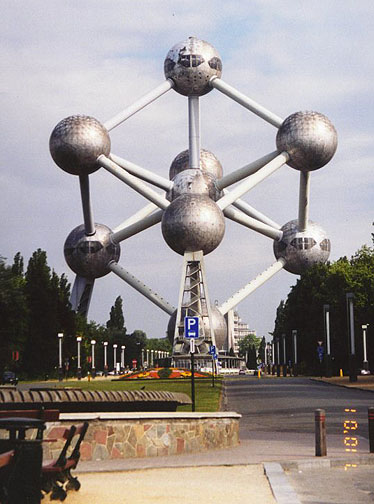

Brussels

Atomium
(symbol of the 1958 Brussels World Fair)
Brussels (French Bruxelles), city in central Belgium, capital and largest city of the country. Bilingual Brussels became one of Belgium's three federal regions in 1993, along with Dutch-speaking Flanders (Flemish Region) and French-speaking Wallonia.
The Laeken Palace
(private residence)The city is located on the Senne River, and boasts tree-shaded boulevards, splendid parks, imposing monuments, and beautiful buildings. Centrally situated in northern Europe, Brussels is internationally important as the headquarters of the European Union and the North Atlantic Treaty Organization (NATO).
European Union Council Building
The Church of Saints Michael and Gudule, a 13th-century Gothic edifice, is famous for its stained-glass windows. Other important ecclesiastical buildings are Nôtre Dame de Finistère and Saint Jacques sur Coudenberg. Among the notable secular buildings are the Hôtel de Ville, in the Gothic style, dating from the 15th century; the royal palace; the 18th-century Palais de la Nation; the 19th-century Palais de Justice; and the Bourse.
Royal Palace
(official residence)The cultural institutions include the Free University of Brussels (1834; since 1970 two universities, one Dutch-speaking and one French-speaking); the École Royale Militaire (1834); academies of letters, fine arts, and medicine; the Royal Library; and the Royal Museum of Fine Arts.
the Botanical Exposition
Brussels is the hub of the Belgian railway system and is linked by canal to the national network of inland waterways and to the sea. The city's port area is situated in the north near Vilvoorde. Among the chief exports are nails, iron, marble, coal, candles, glass, and sugar. Imports include minerals, palm oil, and coffee.
Guild houses on the Grand Plaza
Monument in building on the Grand Place
(kept smooth by people touching as a symbol of Good Luck)The city has long been known for the production of fine lace, called Brussels lace, and for tapestry weaving. Other industries include printing, brewing, distilling, sugar refining, iron and brass casting, and the manufacture of textiles, electronic equipment, and furniture.
statue in the old city
The name of the city is probably derived from Broekzelle, a Dutch word meaning "village of the marsh." The town developed from Gallic-Roman settlements in the marshes of the Senne Valley before the 7th century AD. By the 12th century, commerce and handicrafts were flourishing.
fountain of boy peeing
(dressed in various costumes - here a street sweeper)Trade and industry in Brussels benefited from the promulgation of the charters of 1312 and 1356 by the dukes of Brabant. By the terms of these documents the imposition of taxes was strictly limited, and the people were given a voice in the government. In 1383 Brussels replaced Leuven as the capital of the duchy of Brabant and continued to be a seat of government during the next four centuries. Brabant was absorbed in 1430 by the duchy of Bourgogne and became a possession of the Austrian Habsburgs in 1477. The city was made the capital of the Netherlands in 1530.
Cinquantenaire Arch
King Leopold II
nearby Military Museum
(soldier costumes on display)During the next quarter of a century Protestantism gained many adherents in Brussels and other cities of the Netherlands, which had been inherited meanwhile by the Spanish branch of the Habsburg family. Religious strife finally culminated in insurrection. The Spanish general Fernando Álvarez de Toledo, Third Duke of Alba, who was sent to the Netherlands in 1567 to suppress the revolutionary movement, established his headquarters in Brussels. In the ensuing reign of terror many Flemish patriots were executed in the city, including Lamoral, Comte d'Egmont; and Philip de Montmorency, Count of Hoorn. Brussels remained under Spanish control until 1576, when it joined the victorious Dutch Netherlands.
Exposition Hall for International shows (1936)
In 1585 the city was captured by a Spanish army under the Italian general Alessandro Farnese and returned to Habsburg sovereignty. Brussels was severely bombarded in 1695, during the French invasion of the Spanish Netherlands. The city was captured in 1792 by a French army during the French Revolution and remained under French control until the termination of the Napoleonic Wars in 1815. By the terms of the Treaty of Vienna (1815), Brussels became one of the capitals of the kingdom of the Netherlands, which comprised modern Belgium and the Netherlands.
Hotel in Art Nouveaux style
another Art Nouveaux building
The city was the center of the revolution for Belgian independence and was made the capital of the newly established kingdom of Belgium in 1831. During World War I the Germans held Brussels from August 1914 to November 1918. In World War II the city was again held by the Germans, from May 1940 to September 1944.
statue to Field Marshall Montgomery
whose British forces liberated the city from the NaziA series of constitutional changes between 1970 and 1993 gave Belgium a federal government structure, with greater power ceded to Brussels and the other two federal regions. Population (1992 estimate, greater city) 960,324.
The Koekelberb Basilica
the national Catholic church
![]()
![]()